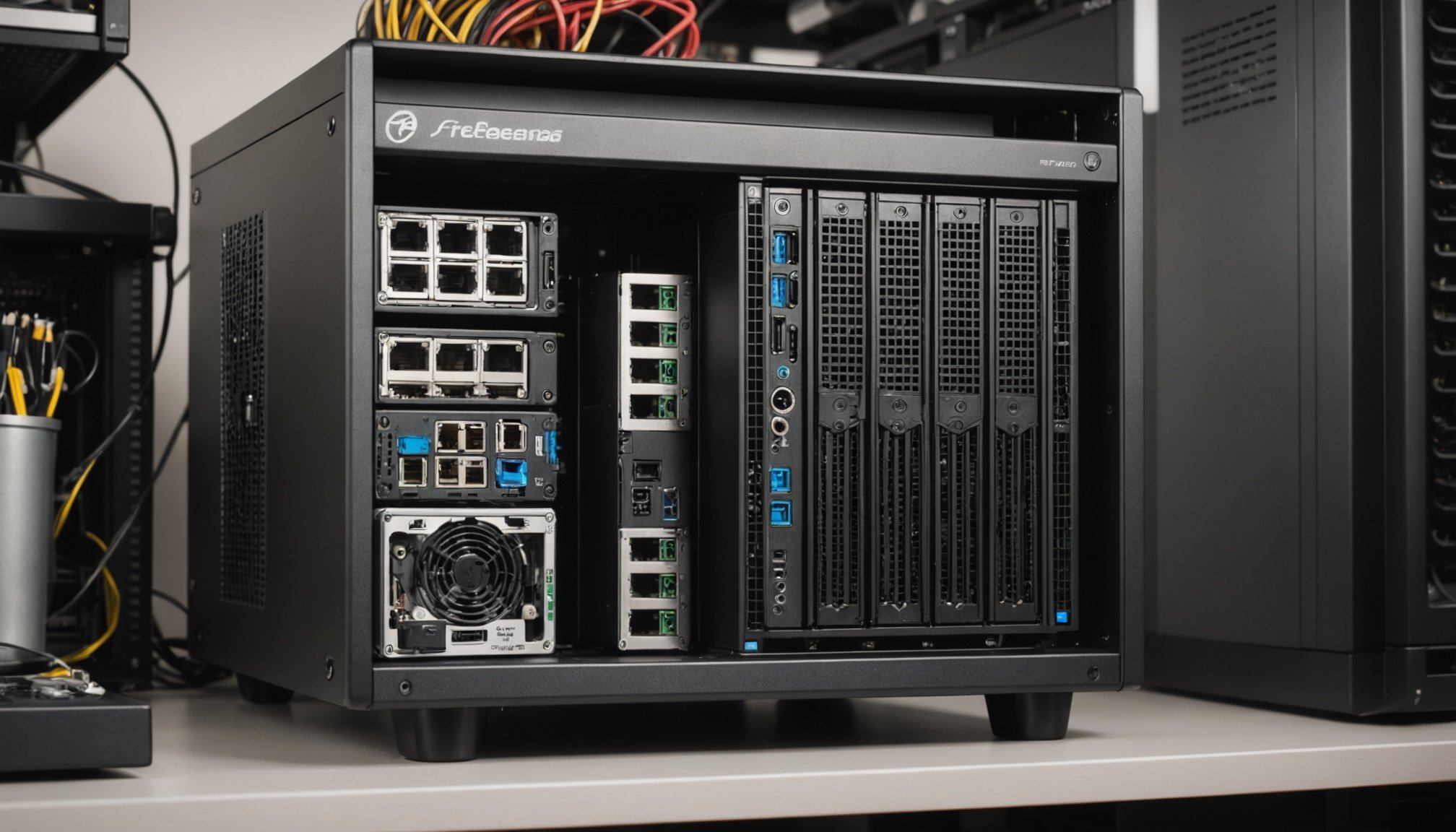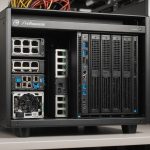Understanding FreeNAS and Its Capabilities
FreeNAS is a robust open-source storage solution designed for effective network-attached storage (NAS) management. It stands out in home network environments due to its versatile features. The solution provides extraordinary flexibility in managing and accessing data while offering a cost-effective alternative to proprietary systems.
At the core of FreeNAS is its comprehensive storage capability. It supports a variety of file sharing protocols such as SMB/CIFS, NFS, and AFP, ensuring seamless integration across different operating systems. This makes it an ideal choice for users seeking reliable storage solutions that foster ease of use and accessibility. File sharing is straightforward, promoting convenient access for all network users.
Moreover, as an open-source platform, FreeNAS offers numerous advantages. The software regularly benefits from updates and enhancements from a vibrant community, which is actively involved in its development. This community support not only ensures the platform’s continual improvement but also provides an extensive knowledge base for troubleshooting and learning.
Embracing FreeNAS’s NAS capabilities makes managing digital assets more efficient and flexible, aligning with the needs of both novice and tech-savvy users. Whether it’s media streaming or file backup, FreeNAS delivers robust performance, standing as a trustworthy choice in the realm of open-source storage solutions.
Also to see : The definitive resource for boosting your alienware aurora r11 gpu: elevate your gaming experience to new heights!
Hardware Requirements for a Custom-Built FreeNAS Server
Building a custom-built FreeNAS server can be a rewarding project, especially for tech enthusiasts looking to manage their own storage solutions. To achieve optimal performance, it is crucial to focus on specific server components.
Begin with the CPU, as FreeNAS relies heavily on processing power for handling numerous tasks, including data compression and encryption. It is advisable to opt for a multi-core processor, such as an Intel Xeon or AMD Ryzen. These options provide the necessary support for multitasking and future scalability.
Next in line is RAM. For FreeNAS, a rule of thumb is to use at least 1 GB of RAM for every terabyte of storage. Many users recommend ECC (Error-Correcting Code) RAM for enhanced system stability, reducing the risk of data corruption over time.
Regarding storage drives, choosing high-quality HDDs or SSDs from reputable brands like Western Digital or Seagate ensures reliability and speed. Consider RAID configurations for redundancy and performance boosts.
The network interface should not be overlooked. A 1 Gigabit Ethernet port is the minimum, though a 10 Gigabit Ethernet connection can significantly enhance network performance over time.
To ensure all components work seamlessly together, verify hardware compatibility. This involves checking manufacturer specifications, online forums, and user reviews for insights into recommended brands and models.
Step-by-Step Installation of FreeNAS
Detailed guidance on installing FreeNAS provides clarity and ensures a smooth setup. Let’s explore each step required to accomplish a successful FreeNAS installation.
Downloading FreeNAS
To begin the FreeNAS setup, the first step is downloading the software from the official FreeNAS website. Ensure you select the appropriate version based on system compatibility. This download is essential to start your journey in data storage and management.
Creating a Bootable USB Drive
Having downloaded FreeNAS, you need to create a USB boot drive. Use tools like Rufus or BalenaEtcher for this task. These applications help format the USB drive and install FreeNAS onto it. A bootable USB drive is crucial for the installation.
- Insert the USB drive into your computer.
- Open your chosen tool, select the FreeNAS file, and initiate the process.
- Ensure the tool formats and writes the image properly onto the USB drive.
BIOS Configuration
Configuring the system BIOS is the next critical step. Restart your computer and enter the BIOS settings, usually accessed by pressing keys like F2, F10, or Delete during startup. You must adjust the boot order to prioritize the USB boot drive before other storage devices. This enables the computer to boot from the USB drive, launching the FreeNAS installer.
Initial Configuration of FreeNAS
Once you dive into the FreeNAS setup, you’ll first encounter the easy-to-navigate web interface, providing a seamless walkthrough for any user. The interface is intuitive, guiding you through essential steps with clarity. To begin, ensure that you are connected to your network to access the interface effectively.
Here’s where configuring the basic network settings comes into play. Start by defining your IP address, which allows for remote access and promotes system accessibility. Ensuring these settings are correct is crucial for ongoing maintenance and monitoring of your server.
Following the network setup, your next focus should be the creation of storage pools and datasets. Storage pools are integral for managing storage resources, providing flexibility in data allocation and redundancy. Within these pools, datasets cater to specific requirements such as compression and deduplication, offering meticulous data management options.
- Access the web interface via a connected network.
- Configure IP settings for performance.
- Establish storage pools for data flexibility.
- Create datasets tailored for your storage needs.
By carefully following these initial steps, you establish a robust foundation for FreeNAS, optimising both functionality and efficiency from the outset. This setup ensures that you are well-prepared for managing your data with precision and reliability.
Advanced Configuration Options
Delving into FreeNAS advanced settings, users can optimize their home server setup by customizing options to enhance performance and expand functionality.
Setting Up Data Shares
Establishing data shares is a crucial step in data sharing. FreeNAS offers the flexibility to create both SMB and NFS shares. SMB, ideal for Windows networks, facilitates easy access and compatibility, while NFS is tailored for Unix/Linux environments, providing efficient file access and transfer. Setting up an SMB share involves navigating to the storage section, selecting the volume, and configuring the share with necessary permissions. Similarly, creating an NFS share requires defining the share path and access permissions.
Configuring User Permissions
Proper user permissions form the backbone of robust data security. In FreeNAS, permissions can be tweaked to grant or restrict access to datasets. It’s advisable to assign distinct permissions for network users and local services. FreeNAS GUI enables administrators to assign permissions efficiently by integrating with directory services or manually configuring user roles. Ensure compliance with security protocols to mitigate risks.
Installing Plugins and Jails
Plugin installation extends FreeNAS functionality, allowing users to run additional applications seamlessly. Through the FreeNAS plugin interface, users can browse a variety of plugins like Plex and Nextcloud. Meanwhile, jails offer a secure environment for application execution. Creating a jail involves selecting the base system, configuring networking, and securing the environment, thus enhancing system agility and resource efficiency.
Best Practices for Performance Optimization
Enhancing FreeNAS performance involves a blend of strategic storage optimization and ensuring data redundancy. By fine-tuning these aspects, users can achieve both efficiency and security.
Techniques for Optimizing Disk Performance and Caching
To maximize disk performance, it’s crucial to implement effective caching strategies. Caching helps in reducing read times by storing frequently accessed data in a faster storage medium. This approach minimizes the load on disks, leading to enhanced performance. Utilizing SSDs for cache drives can significantly improve I/O speeds, ensuring a more responsive system.
Importance of Data Redundancy with Backups and Snapshots
Data redundancy is a cornerstone of a reliable storage optimization strategy. Regular backups create recovery points that protect against data loss. Snapshots, on the other hand, capture the state of the storage system at specific instances, allowing quick restoration without disrupting ongoing operations. Prioritizing this technique ensures that data remains secure and recoverable.
Recommendations for Routine Maintenance and Monitoring Performance
Routine maintenance and consistent performance monitoring are vital in maintaining a balanced storage system. Regular checks and updates help in identifying potential bottlenecks early. Monitoring tools can offer insights into disk usage patterns, enabling users to make informed adjustments. By staying vigilant, the FreeNAS performance can remain optimized over the long term.
Troubleshooting Common Issues
Navigating FreeNAS troubleshooting can sometimes feel overwhelming, especially with the variety of common errors users encounter. However, understanding the support resources at your disposal and employing the right diagnostic tools can make this process significantly easier.
Identifying Common Problems
Users frequently face issues like network configuration errors, permission problems, and disk failures with FreeNAS systems. Often, these can be attributed to misconfigured settings or hardware incompatibilities. Recognizing the symptoms early, such as slow performance or inability to access shares, is crucial for timely resolution.
Diagnostic Tools
When faced with performance or configuration issues, leveraging built-in diagnostic tools can be invaluable. Tools like the Reporting feature in FreeNAS provide insights into system health and potential problem areas, while the “Alerts” feature identifies what needs immediate attention. Regularly reviewing system logs can also pinpoint errors that aren’t immediately obvious.
Community Support and Documentation
The FreeNAS community is a robust support resource. Forums and wikis are rich with user-shared solutions for frequent problems. Additionally, the official documentation offers comprehensive guides tailored to both beginners and advanced users. Engaging with these resources not only aids in resolving specific issues but also enhances one’s understanding of the platform’s intricacies.
Enhancing Data Security on FreeNAS
When securing your data on FreeNAS, understanding the role of data encryption and access control is crucial. Implementing data encryption is vital for protecting sensitive files from unauthorised access. It acts as a safeguard, transforming your data into a code, rendering it unreadable without the correct key. This process ensures that even if data is intercepted, it remains protected.
In addition to encryption, access control options are indispensable for managing user permissions effectively. With FreeNAS, you can allocate specific permissions to different users, granting or restricting access based on roles. It is important to regularly review and update these permissions to ensure only authorised personnel have access to sensitive information.
Securing your FreeNAS server against potential threats requires a multi-faceted approach. Regularly updating the system and software is essential to patch vulnerabilities. Employing firewalls and intrusion detection systems can provide an additional layer of security, monitoring for unusual activities. Furthermore, implementing strong, complex passwords and enabling two-factor authentication can significantly enhance your server’s defence.
Following these strategies not only ensures the safety of your data but also builds confidence in your FreeNAS security measures, empowering you to focus confidently on other tasks while your information remains secure.
Resources for Further Learning
As you dive deeper into FreeNAS, expanding your understanding is crucial. Here are some valuable resources tailored for distinct learning preferences.
Video Tutorials
For those who are visual learners, video guides are a fantastic method to grasp complex concepts. Platforms like YouTube host a plethora of FreeNAS tutorials that walk you through installations, configurations, and troubleshooting in a step-by-step manner. Whether you’re setting up a new system or enhancing an existing one, these tutorials can offer that much-needed clarity.
Documentation and Guides
The official FreeNAS documentation serves as an exhaustive resource for acquiring a thorough understanding. With structured sections that cover architecture, features, and functions, these guides are indispensable for anyone needing detailed explanations. They help demystify complicated processes, making them less daunting for new and seasoned users alike.
Community Forums
Engaging with others who share your interests can significantly enhance your learning. Community forums dedicated to FreeNAS provide a platform for collaborative problem-solving. Users from around the world share insights, solutions to issues, and their personal experiences. Whether you have specific questions or are searching for innovative ways to optimise your setup, these forums can be an invaluable resource.






